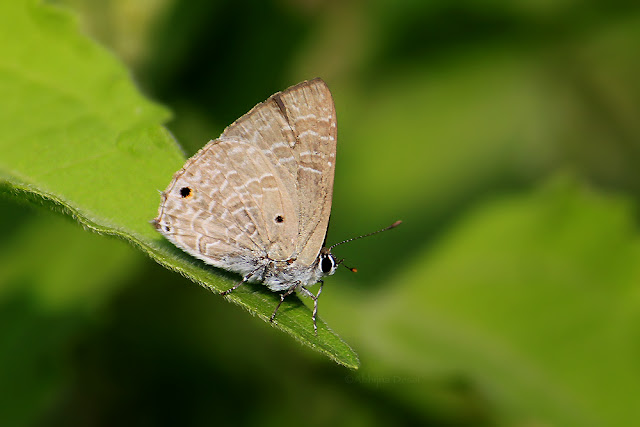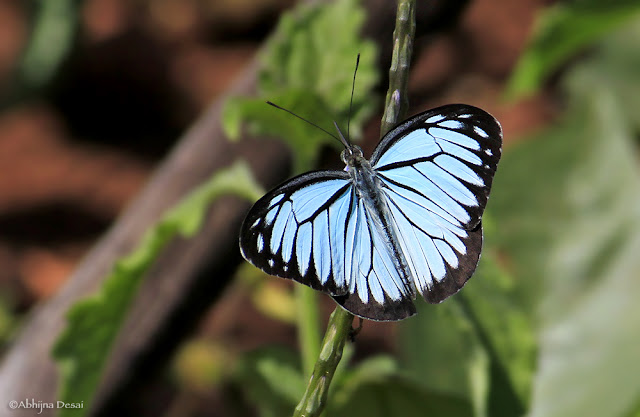The first trip was to Lalbagh on 4th November. Nitin R and I added the 51st species to Lalbagh's list of Winged Jewels. The 50th one was a Commander (Moduza procris)!
The second weekend, 11/11/2012 was to J.P Nagar Reserve Forest. Time spent was about 3 hours. Here are the highlights of the trip!
Dark Brand Bushbrown (Mycalesis mineus). (Resident populations of both mineus and perseus are found in JP Nagar.)
Pointed Ciliate Blue (Ionolyce helicon) which was an addition to the species list of J.P Nagar RF:
Indian Skipper (Spialia galba):
Slate Flash (Rapala manea) an addition to JP Nagar RF's species list!
On 12/11/12, a 2 hour walk in Lalbagh.
Common Albatross (Appias albina), spotted for the third time over the past few months. Lalbagh definitely has a resident population. This one here is a male.
The upper side, intermediate seasonal form of a Plains Cupid (Chilades pandava):
Bevan's swift (Pseudoborbo bevani) feeding on bird droppings:
On 18/11/12, the Bangalore Butterfly Club made a trip to Valley School, spent about 4 hours. This place disappoints no one! Thanks to Kalesh S, we identified three varieties of swifts - Rice Swift, Straight Swift (which appeared to be very common there) and Bevan's Swift.
Angled Castor (Ariadne ariadne):
Forget-me-not (Catochrysops strabo):
Plumbeous Silverline (Spindasis schistacea):
Common Wanderer (Pareronia valeria):
A very special and unexpected sighting of a Common Guava Blue (Virachola isocrates) at Cunningham Road on 22/11/12! Photograph by Nitin R!
On 25/11/2012, a visit to J.P Nagar Reserve forest, time spent - 3 hours.
Made a stunning image of this Crimson Rose (Artrophaneura hector) which is now the wallpaper on my PC! What a fresh beauty!
We also saw a Double Branded Crow (Euploea core) female. Being a migratory species, it was quite unexpected at this time of the year.
A very strangely shaped individual of a Slate Flash (Rapala manea).
Small Branded Swift (Pelopidas mathias), the underside:
Small Branded Swift (Pelopidas mathias), the upperside:
As an added bonus, we found caterpillars of Common Rose (Atrophaneura aristolochiae) and Crimson Rose (Atrophaneura hector) on Aristolochia.
Bangalore may be a busy city, but nevertheless, the butterflies thrive. So, a very special "happy butterflying!" shout-out to all the Bangaloreans reading this post!
The second weekend, 11/11/2012 was to J.P Nagar Reserve Forest. Time spent was about 3 hours. Here are the highlights of the trip!
Dark Brand Bushbrown (Mycalesis mineus). (Resident populations of both mineus and perseus are found in JP Nagar.)
Pointed Ciliate Blue (Ionolyce helicon) which was an addition to the species list of J.P Nagar RF:
The butterfly of the day, Karwar Swift (Caltoris canaraica) which was a new addition to the species list of Bangalore itself!
Indian Skipper (Spialia galba):
Slate Flash (Rapala manea) an addition to JP Nagar RF's species list!
On 12/11/12, a 2 hour walk in Lalbagh.
Common Albatross (Appias albina), spotted for the third time over the past few months. Lalbagh definitely has a resident population. This one here is a male.
The upper side, intermediate seasonal form of a Plains Cupid (Chilades pandava):
Bevan's swift (Pseudoborbo bevani) feeding on bird droppings:
On 18/11/12, the Bangalore Butterfly Club made a trip to Valley School, spent about 4 hours. This place disappoints no one! Thanks to Kalesh S, we identified three varieties of swifts - Rice Swift, Straight Swift (which appeared to be very common there) and Bevan's Swift.
Angled Castor (Ariadne ariadne):
Forget-me-not (Catochrysops strabo):
Plumbeous Silverline (Spindasis schistacea):
Common Wanderer (Pareronia valeria):
A very special and unexpected sighting of a Common Guava Blue (Virachola isocrates) at Cunningham Road on 22/11/12! Photograph by Nitin R!
On 25/11/2012, a visit to J.P Nagar Reserve forest, time spent - 3 hours.
Made a stunning image of this Crimson Rose (Artrophaneura hector) which is now the wallpaper on my PC! What a fresh beauty!
We also saw a Double Branded Crow (Euploea core) female. Being a migratory species, it was quite unexpected at this time of the year.
A very strangely shaped individual of a Slate Flash (Rapala manea).
Small Branded Swift (Pelopidas mathias), the underside:
Small Branded Swift (Pelopidas mathias), the upperside:
As an added bonus, we found caterpillars of Common Rose (Atrophaneura aristolochiae) and Crimson Rose (Atrophaneura hector) on Aristolochia.
Bangalore may be a busy city, but nevertheless, the butterflies thrive. So, a very special "happy butterflying!" shout-out to all the Bangaloreans reading this post!


























































